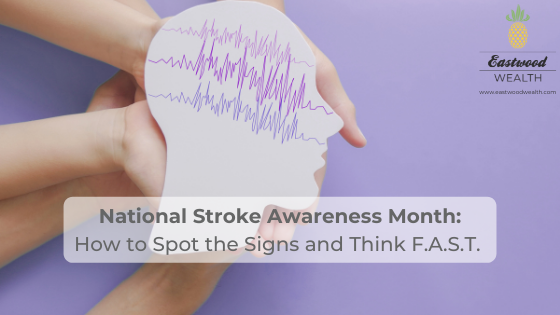May 9, 2022

Strokes may occur at any age but are more prevalent in those who have reached retirement age. A stroke occurs when the blood supply between the brain and an area of the body has been cut off. The effects of the stroke may often be confined to the affected area or may be more extensive, and the symptoms experienced are typically determined by the part of the body lacking blood supply.2
The severity of the stroke depends on how much of the brain tissue is deprived of blood during the duration of the stroke. Mild strokes may result in temporary symptoms, while more severe strokes may cause permanent damage or disability. While there are people who recover fully from strokes, 2/3 of those who survive a stroke have some type of disability resulting from it.2
Think F.A.S.T.
When it comes to detecting a stroke, time is of the essence. Many medications for strokes require administration within a specific timeframe from the onset of the symptoms to be effective. F.A.S.T. has become a go-to acronym for stroke symptom detection and serves as an anagram for the common symptoms.1
- F: Facial weakness, such as problems smiling or drooping eyes
- A: Arm weakness in one or both arms
- S: Speech problems, such as slurring
- T: Time to call 911, if any of the symptoms have been detected1
Other Stroke Symptoms
While the F.A.S.T. acronym helps draw attention to some of the more common stroke symptoms, there are other symptoms you need to be aware of as well. Problems with muscles and coordination may indicate a stroke. If you have sudden weakness or paralysis of a body part or issues with your gait and coordination, you should seek medical attention. Unusual sensations may also be an indication of a stroke, such as numbness or pins and needles feelings in the extremities.1
Other symptoms may arise, including stiffness, problems swallowing, and difficulty controlling your eyelids. Unfortunately, strokes may also result in behavioral and mental changes in some individuals. Those suffering from a stroke may have problems finding the correct words or forming coherent sentences, leading to frustration and anger. A person may be confused or suffer from memory loss from the stroke.
Vision problems, such as changes in vision quality or head pain, are also side effects of a stroke. Vision may be blurred, or a person may lose eyesight in one or both eyes. You also may experience a headache, which may be more severe than other headaches you may have experienced in the past.2
If you suspect that you or your loved one has experienced any of the above symptoms of a stroke, don’t hesitate to seek out medical treatment by calling 911. Every moment counts when it comes to a stroke, and the quicker you are treated, the more opportunity for stroke care.
Footnotes:
1Symptoms of a Stroke, Stroke Association, https://www.stroke.org.uk/what-is-stroke/what-are-the-symptoms-of-stroke
214 Stroke Early Warning Signs and Symptoms, MedicineNet, https://www.medicinenet.com/11_signs_and_symptoms_of_stroke/article.htm
Sources
https://www.stroke.org.uk/what-is-stroke/what-are-the-symptoms-of-stroke
https://www.medicinenet.com/11_signs_and_symptoms_of_stroke/article.htm
Important Disclosures
This material was created for educational and informational purposes only.
All information is believed to be from reliable sources; however LPL Financial makes no representation as to its completeness or accuracy.
This article was prepared by WriterAccess.
Tracking # 1-05277212
VIEW OUR Business Continuity Plan
CFP® Certified Financial Planner™ Certified Financial Planner Board of Standards, Inc. owns the certification marks above, which it awards to individuals who successfully complete initial and ongoing certification requirements.
Securities and advisory services offered through LPL Financial, a Registered Investment Advisor Member FINRA + SIPC.
The LPL Financial registered representative associated with this site may only discuss and/or transact securities business with residents of the Following states: NC, VA, SC, MD, DE and FL.
Financial planning services offered through LPL Financial, a registered investment advisor